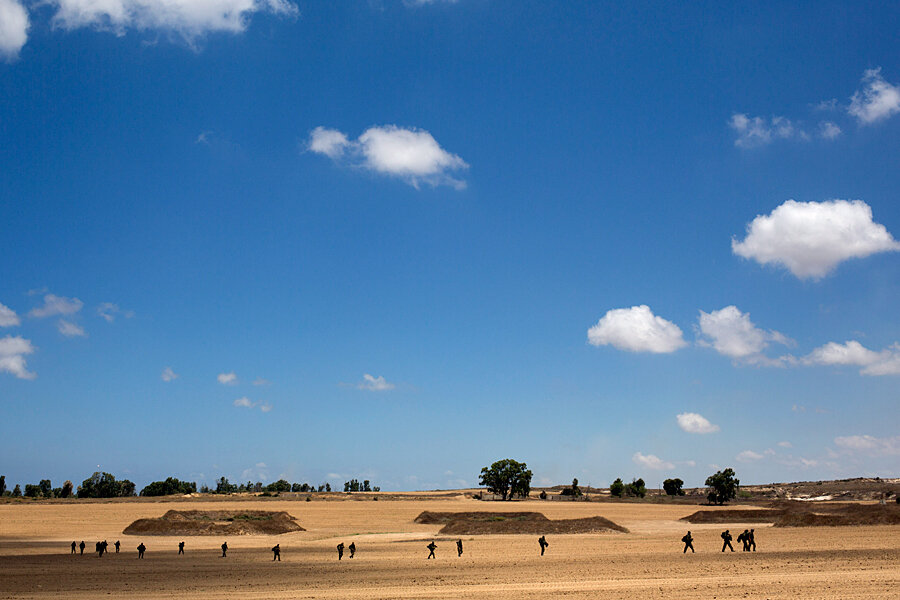Gaza conflict: Israeli fears shift from skies to below ground
| Jerusalem
Israel says that dozens of tunnels now snake underneath its heavily patrolled border with Gaza and present its military with a new challenge that its current offensive is designed to neutralize.
Israel Defense Forces (IDF) officers say the network of underground bunkers and tunnels gives Hamas rare access to Israeli territory, a threat not to be tolerated. “The main goal right now is to locate and destroy tunnels that lead into Israel,” says Maj. Gen. Gadi Shamni (res.), a former commander of the Gaza division, calling the tunnel threat “severe.”
Yesterday the IDF thwarted a cross-border tunnel attack by 13 Hamas operatives on an Israeli kibbutz, and Israeli Prime Minister Benjamin Netanyahu has said the focus of the ground invasion is to destroy such tunnels. Most reports indicate that troops are focused on a narrow corridor along the Israeli border.
The geological makeup of the area and the potential for surprise attacks all make the tunnels a big challenge for the IDF. Back in 2009, when Israel last launched a ground invasion on Gaza, the main tunneling front was along the Gaza-Egypt border, mostly for smuggling. The tunnel used in the kidnapping of Israeli soldier Gilad Shalit in 2006 was adjacent to that area, but now a new front has developed on the Israel-Gaza border.
“This is one of the new things that has been implemented,” says Miri Eisin, a former military intelligence officer who served as a government spokesman during the 2008-2009 war. “Because of that it’s really the major challenge.”
Although ground troops can identify and destroy concealed entrances, it can be difficult to pinpoint a tunnels' route and branches. And while numerous detection systems exist, distinguishing between natural holes in the sandy area and man-made tunnels isn't easy, says Col. Eisin (res.).
“Because the land is so porous it’s hard to distinguish,” she says, even when the tunnels are reinforced with man-made materials. “Concrete doesn’t show up on most of the different kinds of sensors that you have. And that’s part of challenge. You actually have to go to find openings and go in.”
Copying Hezbollah
Hamas’s tunnel network follows the successful use of tunnels by Hezbollah against an Israeli incursion into Lebanon in 2006.
The Lebanese Shiite militant group built its first prototype of an underground bunker in the mid-1980s, which can be seen today at its tourist museum in Mlita, Lebanon.
But it wasn’t until Israel’s withdrawal from south Lebanon in 2000 that Hezbollah began building up an extensive system of underground bunkers and rocket launchers, with an estimated 1,000 facilities by the time of the 2006 war between Israel and Hezbollah. During the fighting, some massive underground networks were found, including one with air conditioning, a cafeteria, dorms, medical facilities, and 3-foot-thick cement ceilings – all built secretly in view of a United Nations outpost along Israel’s border.
Some of Hezbollah’s bunkers are so well-hidden that even with GPS coordinates that lead to within 10 feet of the entrance, they can be hard to spot. While some have been abandoned, Hezbollah is believed to be building even larger facilities, big enough to drive a truck into.
Many Israeli analysts say that Hamas gleaned its tunnel-building expertise from Hezbollah, though it is unclear whether they traveled to Lebanon, hosted Hezbollah operatives in Gaza, or shared knowledge remotely.
The tunnels have allowed both militant organizations to build up their rocket capabilities and preserve an element of surprise in their attacks against Israel, though Hezbollah’s capabilities far outweigh those of Hamas.
Detecting Hamas tunnels
Last fall, Israel discovered and destroyed a mile-long tunnel built more than 60 feet under the border over the course of about a year. An officer who formerly served in the IDF’s geology unit told the Times of Israel that it was professionally done and heavily reinforced with concrete. The fossilized sea shells and deeper water table in that part of Gaza make it more conducive to tunneling, the officer said.
Methods for detection include radio monitors that can indicate cavities and seismic tools that pick up on movement underground – though those can become overwhelmed with the usual bustle of life above the ground.
The IDF reportedly found five tunnels by midday today and it estimates there are dozens more. While a ground presence helps find tunnels, it also increases the risk of Israeli casualties.
“The decision to go in 1 to 2 kilometers (0.6 to 1.2 miles) is our decision. But once you’re in 1 to 2 kilometers and you stay there, you’re sitting there and you’ve become targets that you were not before,” says Col. Eisin, noting that the rocket fire that prompted Israel’s escalation is likely to continue. “Unless you physically conquer all of the Gaza Strip, which takes longer than a week … until the last day there will be firing of rockets.”







